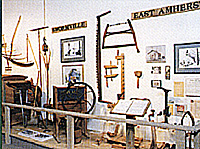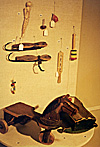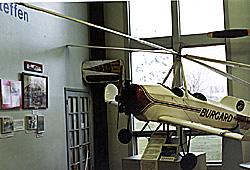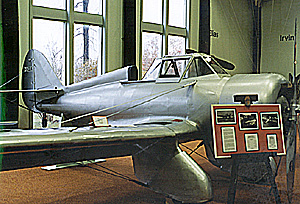 The Shaw Building
The Shaw Building
The spacious Shaw Building houses the main collection of what I call "Americana." Americana, by my definition, is a collection of ordinary tools, clothing, toys, crafts, home furnishings, and other items used by everyday people in everyday settings. In Europe, the collection would be very similar to folk museums.
At right, early "Americana" tools and other implements. Photo courtesy of and © by Amherst Museum
Once you make your way around the 1911 fire cart, you come to the rest of a group of items honoring firemen. These include certificates, toys, and an 1860-70 era four wheel horse carriage belonging to the East End Active Hose Company (Aurora, NY).
 Doubling back, you come to the Gallery of the Senses, a collection of 19th and early 20th century artifacts designed to be handled by sight-impaired visitors.
Doubling back, you come to the Gallery of the Senses, a collection of 19th and early 20th century artifacts designed to be handled by sight-impaired visitors.
At right, Toys on display in the Gallery of the Senses.
Blue Monday
From there, you make your way across the hall to an exhibit entitled: Blue Monday: Washday and Women Exhibit. This contains the items used by women of the 19th and 20th century to wash clothes, from washboards and tubs to washing machines. Monday was the traditional day of washing in the 19th century for two reasons: the family usually changed clothes on Sunday, and Sunday leftovers meant the women did not have to prepare a meal and so had time. Since the scrubbing and washing and wringing and drying were all done by hand, it was an all-day event until the advent of motorized machines. Some of the other items on display include a 1914 Maytag washing machine, 1900 Washer Company "Cataract" washing machine, drying racks, and a notebook filled with personal reminescences of washing day.
Silhouette
Working around the museum is a collection of women's clothing from the 1840s to the present. This exhibit focuses on the silhouette of women through the use of undergarments. For example, four to six layers of petticoats were the norm for the 1840s, plus cinched waists and enhanced busts (18 inches at the waist was the "ideal", and both still evidently carried through on Barbie dolls). By 1860, cage crinoline would rid women of multiple layers of petticoats, and the latter half of the 19th century saw the flattened front and sweeping up of the back in bustles, and the corset was tightly laced along with extensive bust enhancers. Meanwhile, underwear became more colorful and decorative.
By WWI, lingerie became more extravegant, and in 1907, brassieres came into fashion, and a general slimming down of the silhouette became more in vogue.In the 20s, as women pushed for equal rights, style tried to suppress busts and curves. By the 30s and 40s, the figure again started to emphasize the curves, while in the 1950s, the hour glass shape was in vogue, and the bust gained prominence once again with padded bras, sweater girl bras, and strapless bras. [From the pamphlet, "Creating the Silhouette: Undergarments and Fashion 1840-1950", Amherst Museum, Amherst, NY].
Local Displays
Amherst was named indirectly for Lord Jeffrey Amherst, the commander in chief of British Forces, 1759-1760. Surrounding towns each have a small display showing a variety of farm implements, tools, and other Americana. A recreation of Christmas at the Hopkins House (Mr. Hopkins was the first town supervisor) circa 1850s shows two rooms decked in subdued holiday ornamentation, with some presents opened.
The Martha C. Schmidt Decorative Arts Gallery holds display cases full of glassware from the 19th and 20th century, while the Van Brooks Gallery of Communication boasts an impressive collection of radios, radio kits, and Victrolas from the 1920s, as well as a 1914 wireless receiving set. A Children's Museum room has a collection of "period" clothes plus other hands-on exhibits.
Finally, heading to the doors leading out to the historic park of houses, is a series of window displays made to look like shop windows as if you were strolling down an 1890s street. General store, watchmaker, barber shop, and pharmacy tools and products of the trade are laid out.
There is a small museum store, stocked primarily with crafts. Some books are available. I purchased "Detailed Reports: War of 1812," a reprint of an 1815 book about the War of 1812 (just under $25 including tax).
Steffen Aviation Building
 The building is essentially spit in two. One half houses the Niagara Frontier Aviation Hall of Fame, a collection of portrait photographs and plaques honoring those who contributed to the advancement of aviation in the Buffalo area. The other half contains a variety of photographs, illustrations, models, and aircraft parts chronicling the evolution of Buffalo-area aviation, plus the star of the collection, a restored 1936 Cunningham-Hall GA-36 aircraft, as well as a 1/2 scale 1930s Autogiro (at left) -- precursor to the helicopter.
The building is essentially spit in two. One half houses the Niagara Frontier Aviation Hall of Fame, a collection of portrait photographs and plaques honoring those who contributed to the advancement of aviation in the Buffalo area. The other half contains a variety of photographs, illustrations, models, and aircraft parts chronicling the evolution of Buffalo-area aviation, plus the star of the collection, a restored 1936 Cunningham-Hall GA-36 aircraft, as well as a 1/2 scale 1930s Autogiro (at left) -- precursor to the helicopter.
 The GA-36 (at right) was the first to feature double motion wing flaps to lower landing speeds without compromising top-end air speed. It was a dual-cockpit monoplane with fixed landing gear. Although built to be sold to either the Army or Navy, the armed forces declined to purchase the plane. In 1941, this prototype was sold to a Michigan-based aircraft company, which only wanted the engine. It sat outside for almost 30 years until bought by a Rochester man in 1969 who intended to restore it.
The GA-36 (at right) was the first to feature double motion wing flaps to lower landing speeds without compromising top-end air speed. It was a dual-cockpit monoplane with fixed landing gear. Although built to be sold to either the Army or Navy, the armed forces declined to purchase the plane. In 1941, this prototype was sold to a Michigan-based aircraft company, which only wanted the engine. It sat outside for almost 30 years until bought by a Rochester man in 1969 who intended to restore it.
He could not complete the restoration, and the museum bought it in 1991, with restoration finished in 1994.
Of the other items, the most interesting are a photo of a Yak-9 captured in the Korean War and bearing US markings, photo of a Bell P-63 Pinball (armored plated target aircraft used in training to record hits; the firing aircraft used "frangible" bullets), a Chuck Yaeger signed print of the Bell X-1, and a full-size mockup of the "free fall ripcord activated parachute" designed by Leslie Irvin and first demonstrated April 19, 1919.
More Amherst Museum
-
Introduction to the Museum
History of the Museum
Shaw and Steffen Buildings
Historic House Park
1998 Event Calendar
Museum Contact Information, Hours, and Directions
Back to List of Historical Sites
Back to Travel Master List
Back to MagWeb Master List of Magazines
© Copyright 1997 by Coalition Web, Inc.
This article appears in MagWeb (Magazine Web) on the Internet World Wide Web.
Other military history articles and gaming articles are available at http://www.magweb.com